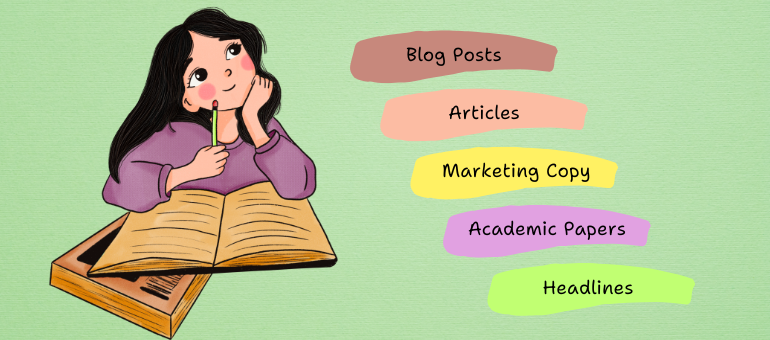
Rewriting Techniques: How to Paraphrase Different Types of Content
21 October 2024
By rewriteradmin
Content Writing
Writers often rewrite content for various reasons such as content repurposing, improving tone and clarity, and for better readability. Unfortunately, many times, the paraphrased contents fail to perform on the search engine result page and don’t live up to meet the readers’ demands.
One of the main reasons for this failure is not rewriting the content according to its specific type. In this blog, we will discuss why rewriting according to content type is necessary, and how to master the techniques of rewriting different types of content.
Why Rewriting According To Specific Content Type is Necessary
There are various kinds and formats of content designed to suit the needs of different types of audiences, platforms, and goals, ensuring that a message is communicated effectively.
Because different audiences consume content in different ways, it’s important to craft the content keeping the target audience, and their preferences in mind. The same goes for different platforms – different platforms prefer different types and formats of content. So, to effectively convey a message to the audience of a specific platform, a writer must tailor his content accordingly.
However, many writers neglect to format content while rewriting them for a specific purpose. So, while they rewrite to avoid plagiarism or to create unique content, many writers often don’t pay attention to the tone, style, and format of the content. As a result, their contents fail to resonate with the audience. That’s why, it’s crucial to rewrite according to the content type.
Rewriting Techniques for Different Content Types
Understanding the complex details and nuances of different content types is essential for successful paraphrasing. Each content type has its own specific style, purpose, format, and tone, which a writer must consider to ensure the content resonates effectively with its audience.
Blog Posts
- Informal Tone: Blog posts tend to have a conversational writing style. So writers should maintain a friendly, informal tone while rewriting blog posts to better connect with their target audience.
- Keyword Optimization: In order to reach the target audience, blog posts must be search engine optimized. Keeping that in mind, writers should optimize paraphrased content by incorporating relevant keywords and improving search engine visibility.
- Call to action: If the original blog content’s goal was to prompt readers to take action, then writers should make sure that the recreated content maintains the same purpose.
Articles
- Formal Tone: Articles typically have a more formal tone compared to blog posts. Content creators must maintain this consistency while paraphrasing articles.
- Fact Checking: Fact-checking the original article’s information and ensuring it remains accurate and consistent in the rewritten content is important while recreating article content.
- Proper Citation: If the original article cited sources, responsible writers must do the same in the rewritten version.
Marketing Copy
- Persuasive Language: Marketing copy pieces are designed to persuade and motivate the target audience to usually buy a product. So, it’s important to keep the thought in mind and use strong, persuasive writing while rephrasing such content.
- Target Audience: Writers must identify and understand the target audience of the original copy. Then they should make sure that the rephrased content appeals to that target audience.
- Brand Voice: Usually, marketing copy contents reflect the brand identity. So, writers should maintain the original copy’s brand voice throughout the rewritten copy as well.
Academic Papers
- Scholarly Style: Academic papers adhere to specific formatting and citation styles (e.g., APA, MLA, Chicago). It’s crucial to follow these guidelines carefully while rewriting.
- Evidence-Based: While rephrasing academic papers, writers must ensure the rewritten content is supported by credible sources and backed up by factual evidence.
- Clarity and Conciseness: Academic writing should be clear and concise. One should avoid unnecessary jargon or complex sentence structures and make sure it’s easily readable.
Headlines
- Short and Strong: Headlines are all about turning heads. So, it’s important to create powerful and compelling content. The rewritten headline must be catchy and interesting for people to notice and desire to read further. Headlines and titles also must not include any unnecessary words.
- Optimizing for SEO: Since search engines pick up on the headlines and titles while suggesting results, writers must include relevant keywords in the rephrased title for better visibility.
Tips for Rewriting Any Content:
- Paraphrasing: Express the same idea using different words and sentence structures.
- Sentence Restructuring: Rearrange the words in a sentence to create a new variation.
- Synonym Substitution: Replace words with suitable synonyms to change the wording without altering the meaning of the original content.
- Idea Reordering: Rearrange the order of ideas or paragraphs to create a new flow, and a unique style.
- Avoid Plagiarism: Check the content’s uniqueness with an online plagiarism checker and make sure the rephrased content doesn’t significantly copy any other existing content.
- Proofreading and editing: Whether rewriting or creating content from scratch, a writer must proofread and edit to ensure correct grammar uses and a solid, strong content body.
Self-Editing: A Crucial Skill for Every Writer’s Ultimate Success
If properly rewritten, a piece of content can get better than its original version. However, to ensure that writers and content creators have to understand different types of content and follow the correct techniques.



